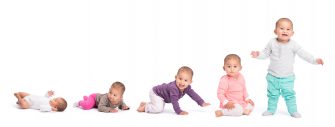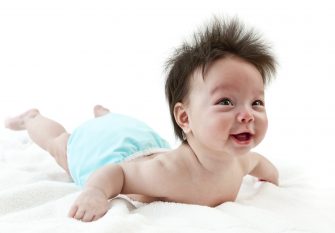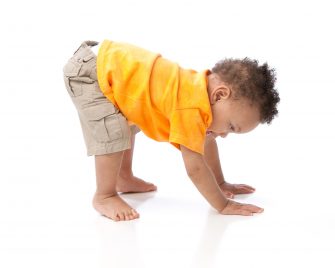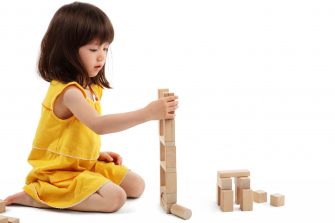Aspects of Natural Movement Development
 “She found her hands yesterday.”
“She found her hands yesterday.”
“He’s discovered he can roll over.”
“She’s learned to move around the room by rolling and scooting.”
“He realized he can make noise.”
These are all common comments among parents of infants. It is amazing to watch a child notice their own body for the first time and learn to control how it can work. Things that will be taken for granted a few short weeks later are new and exciting to both parent and child. We may not think about how these milestones will affect their life moving forward (at least not beyond the next few milestones). However, research has shown that basic development milestones may be a predictor of childhood neurobehavioral development.
Most basic elements of movements are acquired during the first two years of life.
Birth – Laying on their Back
A newborn typically lies on his back, with bent limbs. Because the body is not developed equally, the child will usually turn their head to the same side consistently. Movements are accidental, abrupt and jerky,
Turning the Head and Discovering the Hands
In time, children learn to follow an object with their eyes. Then they will start turning their heads to continue to follow movement. Children also “discover” their hands and begin to develop purposeful movement with them. With repeated practice, they will get more coordinated and develop different types of movement such as forming a fist and opening it again.
Turning to the Side
As children perfects grasping a hold on things, they will begin to reach for items that are not currently in their reach. Stretching and reaching towards items, will, in time, allow them to pull over onto their side. They also develop the ability to roll to their side by turning his pelvis. This new position is challenging to balance, so they will roll (or sometimes “fall”) onto their back to rest. With practice, they learns to lay on their side well and can then turn their attention to the new view of their surroundings.
Turning on the Belly and Back Again
When laying on their side, visually exploring their world, children may forget to maintain their balance and fall over onto their belly. This can also happen when on their side, they reach for something or if their momentum for turning onto their side is a little more than is needed. It is common for an arm to get caught under the body which typically upsets the child. But once they are helped to return to their back, it’s often not long before it happens again. While the caregiver helps with this in the beginning, children will find their own solution sooner or later.
When newborns are placed on their belly, they may lay their head down to one side and the rest of their body follows so that they rolls to their back. However, as children develop the ability to purposefully lift and turn their head, and roll from their back to their belly, they may have trouble returning to laying on their back. However, it generally doesn’t take long for the body to incorporate this new knowledge of movement and to enable a child to roll in both directions.
Tummy time
Lying on the belly is a learned skill. Initially the infant can only lift the head, then learns to use hands and arms as well. Still, this takes work, and the infant will often return to laying on the back more. There is an old adage that says “use it or lose it”, but for infants, they must use their muscles in order to develop them! Play mats to look at, toys to reach for, or just laying down with children to play helps them get used to the different points of view and enjoy this active time. (For more information specifically on Tummy Time, see https://www.tnchiro.com/articles/do-infants-really-need-tummy-time-yes/)
Stretching
When the infant gets comfortable rolling from back to belly and back again, is the beginning of the infant being able to navigate around an area. It may be difficult to detect, if the infant is fully clothed, but if you watch closely, you will see the child bend and stretch making tiny movements much like a caterpillar does. Given time, the infant will move across space to reach the desired object. Resist the urge to pick up children to move them across the room if it’s not necessary. Not only are they continually learning more about their surroundings, this process is incredibly important for motor development! These movements help straighten the spine and strengthen the muscles of the trunk. In fact, these movements are performed as special physical-therapy exercises with children who have spinal disorders. Forcing a child to sit or stand can take away from this vital time. Left to themselves, they will stretch, toss and turn on their own and build the necessary strength and flexibility they will need later.
Rolling
As infants enter the second half of their first year, they are perfecting their skills at rolling and using those movements to reach an object of interest. As they continue to move themselves, the body becomes stronger so that they spend more time on their belly. They will develop a posture that allows easy movement of the head, neck, arms and legs.
From Creeping to Crawling
The last few months of the first year, infants will begin to creep on their belly. Many children move backwards first, then learn to move forward. It is often humorous to watch infants in this stage as they experiment with various movements. Some use their arms more while others get more action from their legs. Some use both as if they were swimming. Whatever method works best for them, infants may become so strong in this movement that they could outpace an adult attempting to move in the same way. Practice strengthens muscles and in time, these muscles will lift children up to their hands and knees. They will begin to crawl, and then walk on all fours much like a bear. In between, they will try many variations of these movements as their bodies become stronger and they learn better control.
Children whose trunk muscles are weaker tend to stay in the creeping stage longer. This allows their body the time to become stronger. In their own time, the children will learn to sit and stand on their own like their peers.
To get the practice needed, children need adequate space to crawl around, like a room as opposed to a small crib. Setting up obstacles can help the child stay in a space that is safe for them, while allowing them freedom to move about. Of course, while pillows may work for a short time, more sturdy and secure obstacles such as baby gates will be needed as the child becomes more mobile.
 Getting up into the vertical
Getting up into the vertical
The natural progression continues, and children begin to pull themselves up as they approach their first birthday. It is not a speedy process. It can often take from 5-6 months from the time they first roll onto their belly until they stand. Every movement must be practiced, and the muscles involved strengthened before children progress to the next step and then, finally, put them all together to stand on their own. Children often begin to stand around the same time as they begin to sit on their own. When they begin to stand, they put only a small amount of weight on their feet and may hold themselves up by leaning or holding onto something. They may initially stand on their toes rather than flatfoot and have their legs spread apart. This is not an efficient way to stand, so they will get tired and fall or sit back down. As they practice, children learn to put more weight on their feet and not hold onto things for support. Their knees begin to loosen and children will start to straighten up their stance. They go from most of their weight on their hands and belly, to being able to balance themselves on their feet with only minimal assistance. They then learn to stand independently.
 Sitting
Sitting
Like other movements, when children first learn to sit up, they are not doing it very well. They may sit with a crooked back and get tired quickly. They will return to laying on their back or stomach to play while they rest. Repeated attempts gradually strengthen the back until a child can “sit well”. After trying various positions, children will find the best way to balance themselves. When they are sitting well, their weight is on the sitting bones, the lower back is straight and the head in in line with it. This allows a child to sit in a way that is restful. From there, children can move easily from that position, turn to either side or bend forward or backward.
Walking on their Own
Only when a child is able to stand and play in that standing position is she truly ready to walk. It is often 4-6 months from when children learn to stand to when they can walk. Then, they may begin to “take off” on their own. Still, it will be a little longer before they use walking as a mode of transportation. Children will often sit down, crawl, then stand back up. Additionally, they will generally continue to play in a squatting, or kneeling position. While they initially walk with their arms out for balance and with their feet turned inward, as they get more practice, these diminish.
How Milestones Relate to Later Development
A new study just published in September, 2022, revealed that infants’ ages when reaching milestones are associated with later development. They analyzed records of over 5,000 children aged 9-10. They looked at 4 milestones: first roll over, unaided sitting, unaided walking, and speaking first words and defined delay using the 90th percentile age as reported by their mothers. They also evaluated neurocognitive function and behavioral problems of the children at the time of the study. They found delays in first roll over, unaided sitting, and walking delays were correlated with poorer childhood neurocognitive function. They also found delay in speaking first words to correlate with poorer neurocognitive function as well as behavioral problems. The children that experienced delays in multiple milestones also displayed the worst lowest neurocognitive function and behavioral outcomes. The researchers concluded that the motor and language milestone delays can be used to predict childhood neurobehavioral outcomes.
By understanding how foundational milestones can be important building blocks for future development, we can better create opportunities for early movement and play to prevent any avoidable delays that may negatively impact a child’s development going forward.
Chiropractic care helps ensure that the spine is properly aligned as children progress through the growth process. Proper spinal alignment helps the body function at its optimal level at any age, promotes natural growth and movement as well as reduces musculoskeletal impediments that could hinder a child’s development. Talk to your chiropractor about how gentle, effective chiropractic care can be part of your children’s foundation for a healthy life.
RESOURCES:
Pikler, Emmi. The Development of Movement – Stages. Sensory Awareness Foundation publication BULLETIN (Number 14/Winter 1994). an excerpt from PEACEFUL BABIES – CONTENTED MOTHERS. https://thepiklercollection.weebly.com/development.html accessed 2/2/2023
Caro, Clare. “The Genius of Emmi Pikler” The Pikler Collection https://thepiklercollection.weebly.com/history.html accessed 2/2/2023
Alves JGB, Alves GV. Effects of physical activity on children’s growth. J Pediatr (Rio J). 2019 Mar-Apr;95 Suppl 1:72-78. doi: 10.1016/j.jped.2018.11.003. Epub 2018 Dec 26. PMID: 30593790.
Zhuo H, Xiao J, Tseng WL, Liew Z. Developmental Milestones of Infancy and Associations with Later Childhood Neurodevelopmental Outcomes in the Adolescent Brain Cognitive Development (ABCD) Study. Children (Basel). 2022 Sep 20;9(10):1424. doi: 10.3390/children9101424. PMID: 36291360; PMCID: PMC9600325.